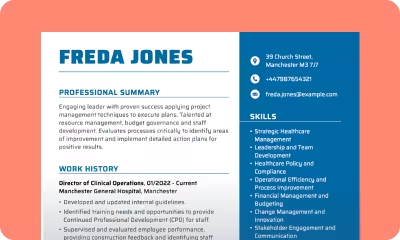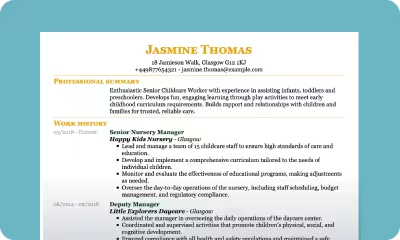- Our customers have been hired by : *Foot Note
A CV that’s well written and targeted to the specific job you want is the first step towards your taxi driver career. In order to catch the eye of a prospective employer, it’s important that your CV lists all the relevant skills and experience.
It is very helpful at this stage to read through a taxi cab driver CV sample, as this can give you a better idea of what is expected. Our taxi cab driver CV sample and CV templates below are a great starting point. Follow our expert advice and kick-start your new career.
We’ll answer all your questions, including how to write a persuasive personal statement and cover letter.
Here, you will learn how to write a CV for a taxi driver, including:
SEARCH ALL CV EXAMPLES
Sample taxi driver CV
Sam Marks
45 Haim Close, Bradford BD1 6YH
07912345678
Sam.Marks@example.co.uk
Professional summary
Reliable Taxi Driver familiar with road regulations, local roads and traffic patterns. Flexible schedule with willingness to work any hours. Able to maintain passenger satisfaction with exceptional service.
Work history
January 2017 – Current
Red Cab – Bradford
Taxi Driver
- Answered, scheduled and responded to reservation calls promptly and professionally.
- Completed safe journeys by applying defensive driving techniques and complying with Highway Code.
- Kept vehicles spotlessly clean and tidy for maximum customer comfort.
January 2014 – January 2017
Celebrity Taxi – Bradford
Private Chauffeur
- Maintained impeccably clean vehicle for optimised hygiene and client satisfaction.
- Provided 24/7 flexibility to clients, providing optimal availability during working hours.
- Provided polite, courteous, professional care from opening passenger doors to careful luggage and passenger set-down.
Skills
- Cash handling
- Private hire driving
- Airport transfers
- Urban driving
- Passenger assistance
- Customer service
- Traffic patterns familiarity
- Map reading
- Local road knowledge
- Mechanical systems
- Vehicle operations
- Vehicle maintenance
Education
Bradford College Bradford – 2012
Vehicle maintenance course
Taxi driver CV format
There are two popular CV formats you could use when crafting your taxi driver CV – the reverse-chronological CV or the skills-based CV. While employers and recruiters accept both, the reverse-chronological CV is often the most persuasive.
It outlines your experience and skills, starting from your most recent job role. Remember to note career achievements that show progression, like promotions or training courses. The overall structure of a reverse-chronological CV includes:
- Contact details – name, address, phone, email address
- Personal statement – a short and snappy introduction
- Work history – list three to six responsibilities for each job
- Skills – relevant or transferable
- Education and additional training
- Other interests or non-work-related accomplishments
Many people come to taxi driving as an exciting career change, or they might be looking for a flexible side hustle to complement full-time employment. As such, they might not have relevant work experience. If you’re in this position, tailor your CV to highlight transferable skills. For instance, you might have managed deliveries and transport logistics in your last sales or administration job.
Alternatively, choose a skills-based CV format. The skills section follows the personal statement to shift the focus away from work history. Although some recruiters recommend avoiding a skills-based CV, it’s effective when you offer tangible examples of how you can put your abilities into practice.
Top tips for taxi driver CV writing
Lead with hard skills
Your taxi driver CV needs to quickly reassure employers and recruiters that you have the necessary qualifications. Otherwise, they may gloss over your application. In your personal statement and cover letter, mention that you have a valid driver’s licence and at least one year’s driving experience. Underline any other essential certifications, like the DVSA taxi test.
Prioritise customer service
Taxi companies want friendly and sociable candidates – grumpy cabbies are bad for business. Include customer-facing roles in your work experience section and give examples of transferable skills. You could talk about a time you solved a challenging customer problem and how that’ll serve you moving forward.
Think outside the box to keep your CV relevant
If you’re considering a career change, you might not have many relevant past jobs to include on your CV. The solution? Think outside the box to showcase your expertise. Or complete a complementary college course to improve your skills and leap ahead of the competition.
Use short, concise sentences
Resist the temptation to stuff your CV with meaningless information. Instead, use short sentences, bullet points and clear headings to attract attention. Employers and recruiters will appreciate the abbreviated and easy-to-read format.
Writing a cover letter for a taxi driver CV
Most job applications only get through the door if they include a well-thought-out cover letter It’s not a rehash of your CV but a summary of your experience tailored to a specific role or company.
A taxi driver cover letter should include:
- A polite greeting
- An introduction – explain your background and reason for getting in touch
- The main body of the letter – describe why you’re applying for this position and what makes you the best choice
- enthusiastic sign-off
Above all else, ensure your personality shines through. Your cover letter is a chance to grab the recruiter’s or employer’s attention by underscoring your unique attributes and skillset.
How to write a CV for a Taxi Driver
Once you’ve decided on the format you want, it’s time to start writing your CV. We know it’s not easy… However, with our tips, writing a CV will turn out to be quick and easy. See how you can create a great CV for a taxi driver step-by-step:
- How to add contact details to your taxi driver CV
- How to write a personal statement for your taxi driver CV
- Taxi driver CV work experience
- Great skills to add on your taxi driver CV
- Taxi driver CV education
How to add contact details to your taxi driver CV
Up-to-date and easy-to-find contact details are a must-have for your taxi driver CV. Place them at the top of the page, so recruiters and employers don’t miss them. Make sure to include your:
- Full name
- Address and postcode
- Email address – keep it work appropriate
- Phone number
Example of contact section for taxi driver CV
Jane Porter
129 Bridge Street, WX1 2YZ
07777 666 777
jp1989@wemail.com
How to write a personal statement for your taxi driver CV
A personal statement is your chance to shine and outline what sets you apart from the competition. It’s an abbreviated paragraph, often only three to four sentences, highlighting experience, results and expertise. The snappier, the better – your goal is to keep the recruiter or employer wanting to read more.
Follow these simple rules to write a personal statement that stands out:
- Write in the third person to sound more professional
- Quantify achievements and mention numbers, like how many pick-ups and drop-offs you can do in a day
- Use confident, positive adjectives
- Explain everything concisely in three to four sentences
Example of personal statement for a taxi driver CV
An experienced and friendly driver working in and around Woking since 2014, with excellent knowledge of the area. Skilled in planning routes and time management. Competent and careful, with a strong focus on the safety of passengers and other road users. Holds a council licence with the wheelchair enhancement.
OR
Taxi driver accustomed to working with a range of passengers, including elderly and disabled customers, children, and women travelling alone. Carries our regular vehicle maintenance to ensure cleanliness and a better passenger experience. Possesses good communication skills and enjoys meeting new people and helping them on their way.
Taxi driver CV work experience
Work experience is the key to a winning taxi driver CV. It’s an opportunity to show recruiters and prospective employers why you’re suitable for the role and how your past duties will feed into your new position. As well as mentioning driving experience, remember that the best cabbies are warm, welcoming and helpful.
List your roles in reverse-chronological order, starting from your most recent employment. Note important information like:
- Role title
- Place of employment
- Dates of employment
- Brief summary of duties
If you’ve never had a driving job before, think outside the box. Highlighting customer service experience is an excellent start because companies seek sociable candidates who can hold a conversation. Have you had any driving duties within non-specific roles, like completing deliveries for sales customers? Can you give an example of demonstrating impeccable road safety awareness? Alongside full-time and part-time employment, include relevant internships, summer jobs and volunteer positions.
Once you’ve summarised your employment history, double-check for grammatical errors and repetitiveness, making sure job duties don’t overlap. The most compelling CVs also focus on achievements that back up your expertise, so shout about any awards you’ve won or times you’ve exceeded expectations. For example, you might have a five-star Uber driver rating.
Example of work experience for a taxi driver CV
Mini cab driver, Station Cars (2014 – present) Duties included:
- Responding to radio calls
- Helping passengers with luggage
- Assisting passengers with mobility problems
- School runs
Delivery driver, Pizza Perfect (2013 – 2014) Duties included:
- Working shifts
- Route planning
- Handling payments
- Cleaning and maintaining vehicle
Great skills to add on your taxi driver CV
The CV skills section should include a mixture of hard and soft skills. Hard skills are training-based qualifications, while soft skills speak to your personality traits. Recruiters and employers look for both when assessing your suitability for a role. When writing your taxi driver CV, here are some must-haves and desirables to include:
Essential skills for taxi drivers
- DVSA taxi test, including the wheelchair test
- Licensed by the local council
- Clean driving licence
- CRB checked
- At least one year’s driving experience, or three years for London
- Basic computer literacy and numeracy skills
Desirable aptitudes to set you apart
- A warm and approachable manner
- Good technical knowledge of vehicles
- Superb geographical knowledge
- Physically fit to help with loading and unloading
- Excellent time management skills and punctuality
- Patience
Taxi driver CV education
While you don’t need any formal qualifications to become a taxi driver, it can set you apart from other candidates. Most recruiters look for two or more GCSEs at grades 9 to 3 (A* to D). English and maths are essential because you have to chat with customers, decipher maps and manage fares. You must also demonstrate computer literacy – taxi firms rely on digital mobile systems and satellite navigation.
You can also reiterate mandatory and complementary training in the education section. Talk about the driving assessments you’ve completed, alongside supplementary road safety awareness courses and first aid courses. Plus, note when and where you gained your taxi driver’s license.
When listing education or other qualifications, include:
- The school, college, university or other awarding body
- The year you started and finished your studies
- The qualification level – GSCE, BTEC, diploma
- The qualification result
- The subject or course title – not required for high school
Example education section for a taxi driver
Woking College, 2013 Vehicle maintenance course
Woking College, 2012 Five GCSEs, including English and Mathematics, grades A – C
Your taxi driver CV questions answered
What should a taxi driver put on a CV?
A taxi driver CV should include a mixture of qualifications, hard skills and soft skills to demonstrate your aptitude for the role. Ideally, you’ll have a relevant work history, but you can also highlight transferable qualities from other industries, like patience, punctuality and problem-solving.
What skills does a taxi driver have?
Taxi drivers have a wealth of skills that make them suitable for long days on the road. The best cab drivers possess:
- Competent driving skills backed up by assessments
- Good knowledge of road and traffic systems
- Sensitivity to passengers of all backgrounds
What are taxi driver responsibilities?
One of the best things about becoming a taxi driver is the varied job role. Every day delivers something new and exciting. Taxi driver responsibilities include but are not limited to:
- Pick-ups and drop-offs in the local and surrounding areas – some firms might require long-distance travel
- Sat Nav and GPS navigation
- Setting fares, managing payments and issuing receipts
- Loading and unloading the vehicle
- Vehicle maintenance, including minor repairs and adjustments
- Operating wheelchair lifts
- Making people feel comfortable and safe during their journey
Is taxi driving a good job in the UK?
Taxi driving is a popular job in the UK, thanks to its flexibility. You have more freedom to set your working hours around family commitments. It’s also an attractive role for people who want to supplement their primary source of income around their traditional 9-5. Taxi drivers in the UK can earn upwards of £30,000 per year working peak times.
Build a taxi driver CV today
Are you ready to create your taxi driver CV? Alongside great CV examples, our online builder has a selection of pre-made CV templates to help you get started. With pre-written content and drag-and-drop functionality, it’s easy to tweak your CV to the desired format to suit your experience level.
*The names and logos of the companies referred to above are all trademarks of their respective holders. Unless specifically stated otherwise, such references are not intended to imply any affiliation or association with myperfectCV.




